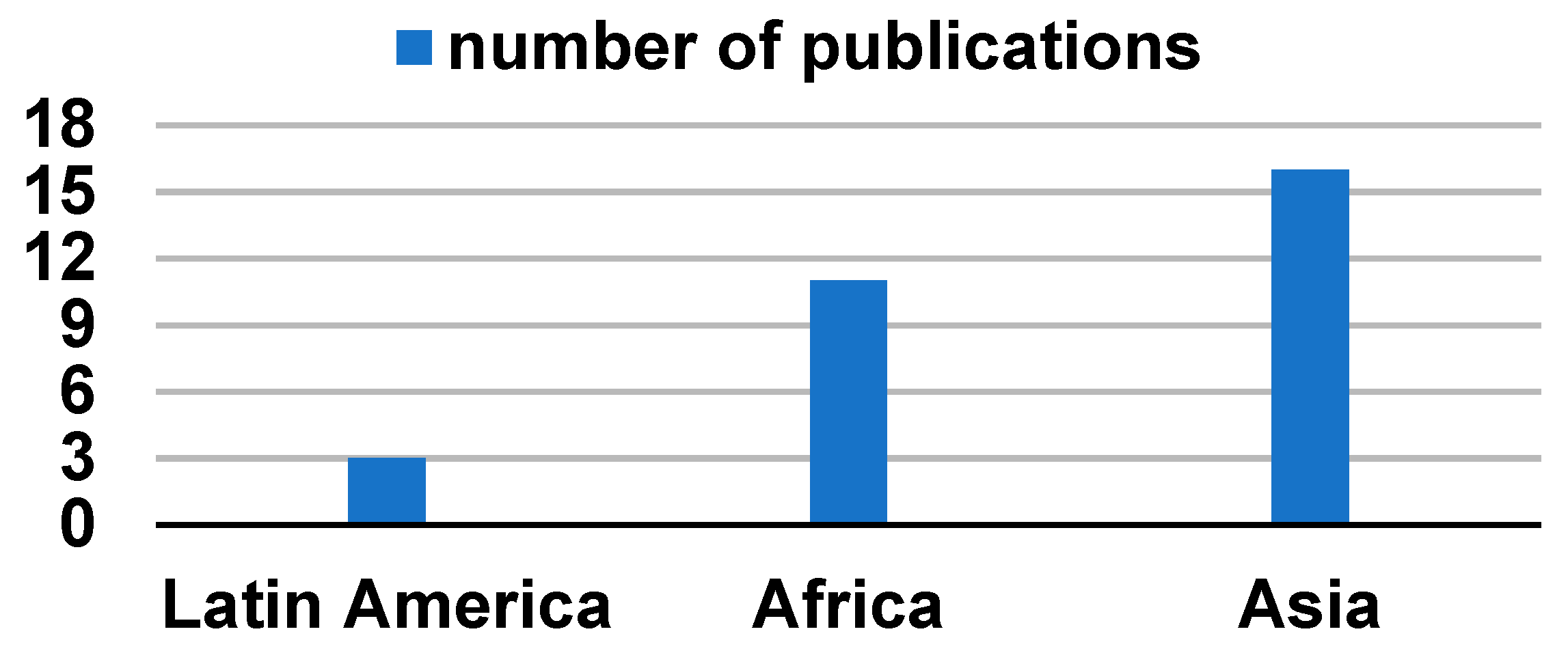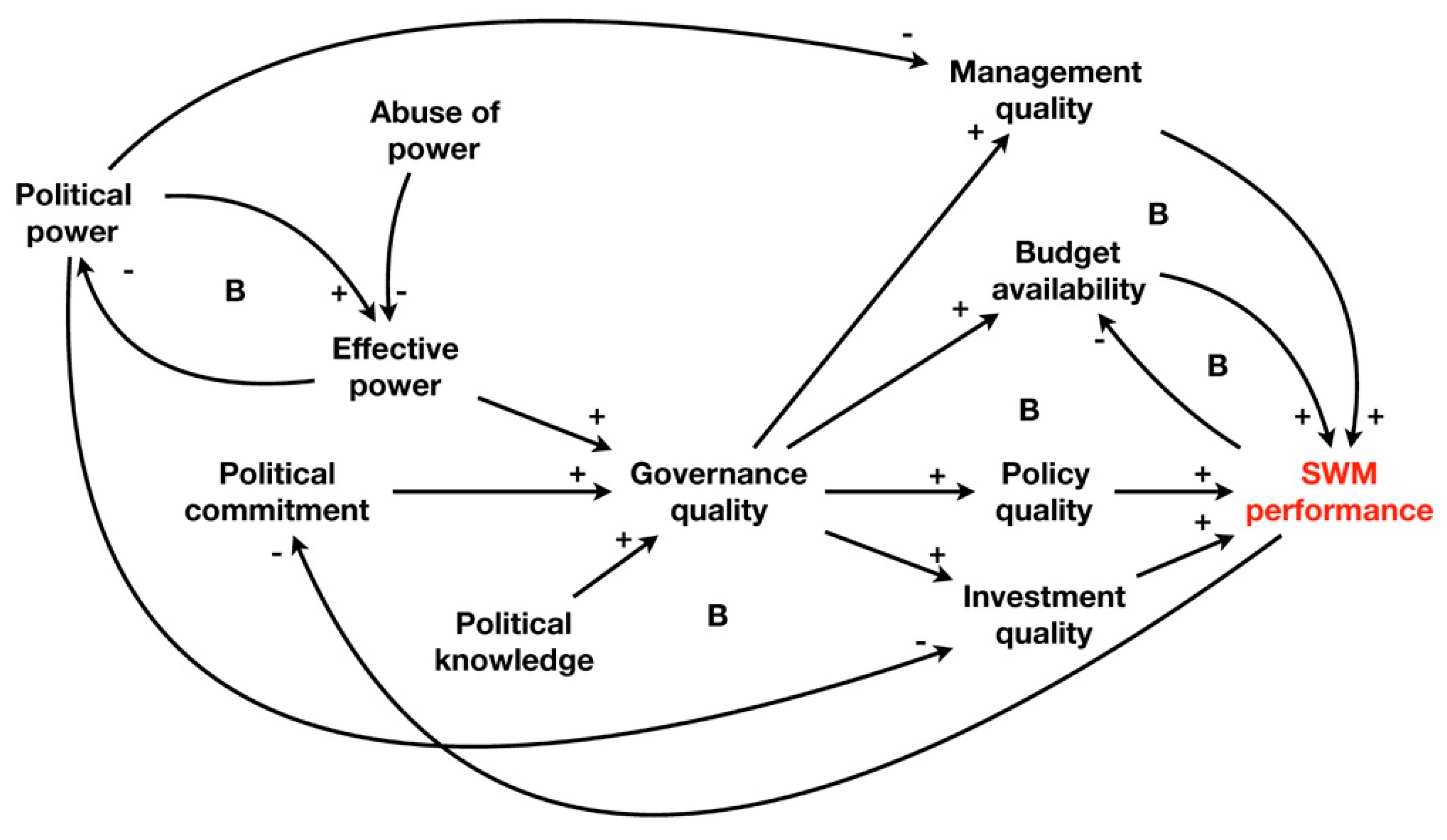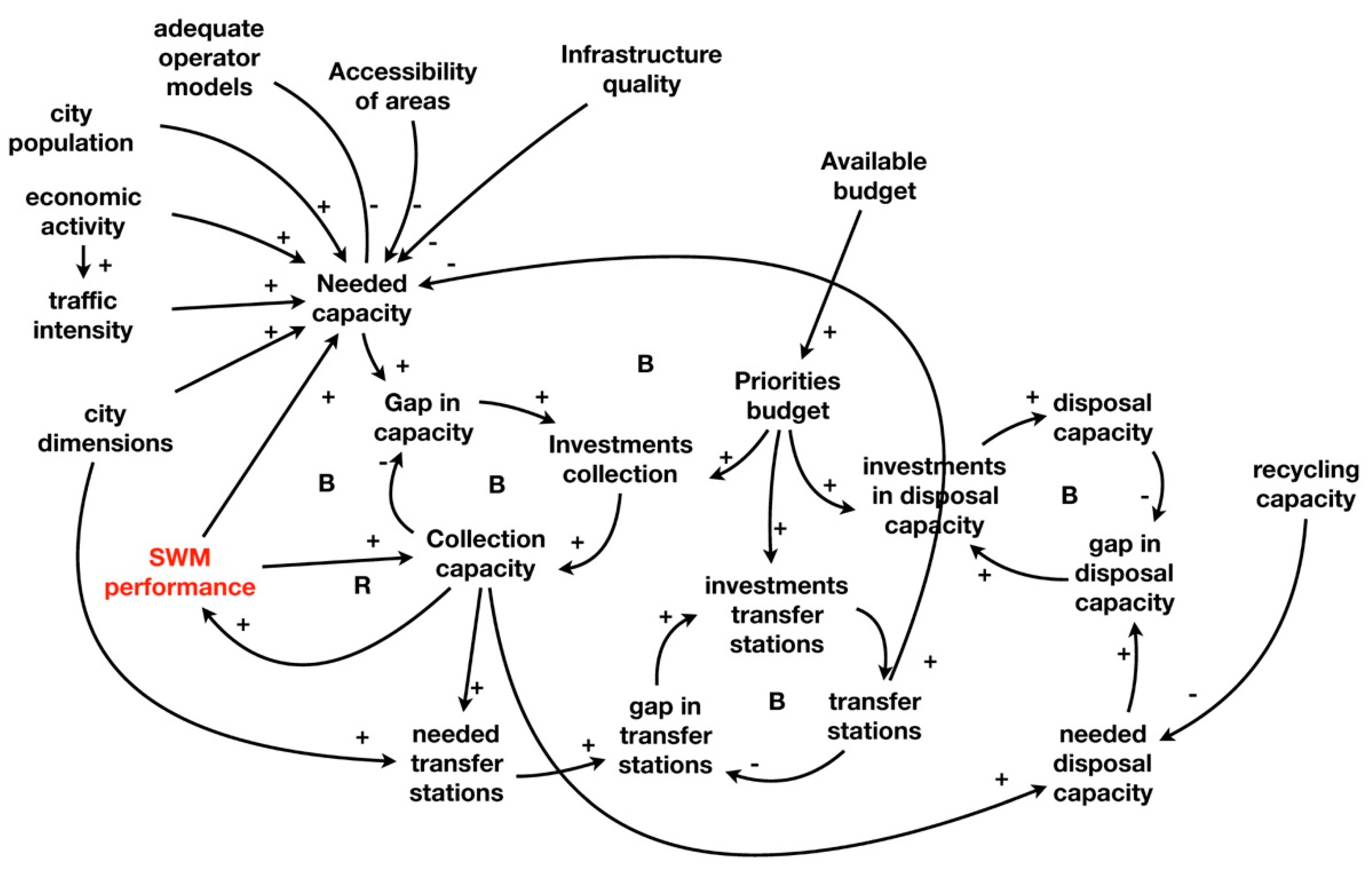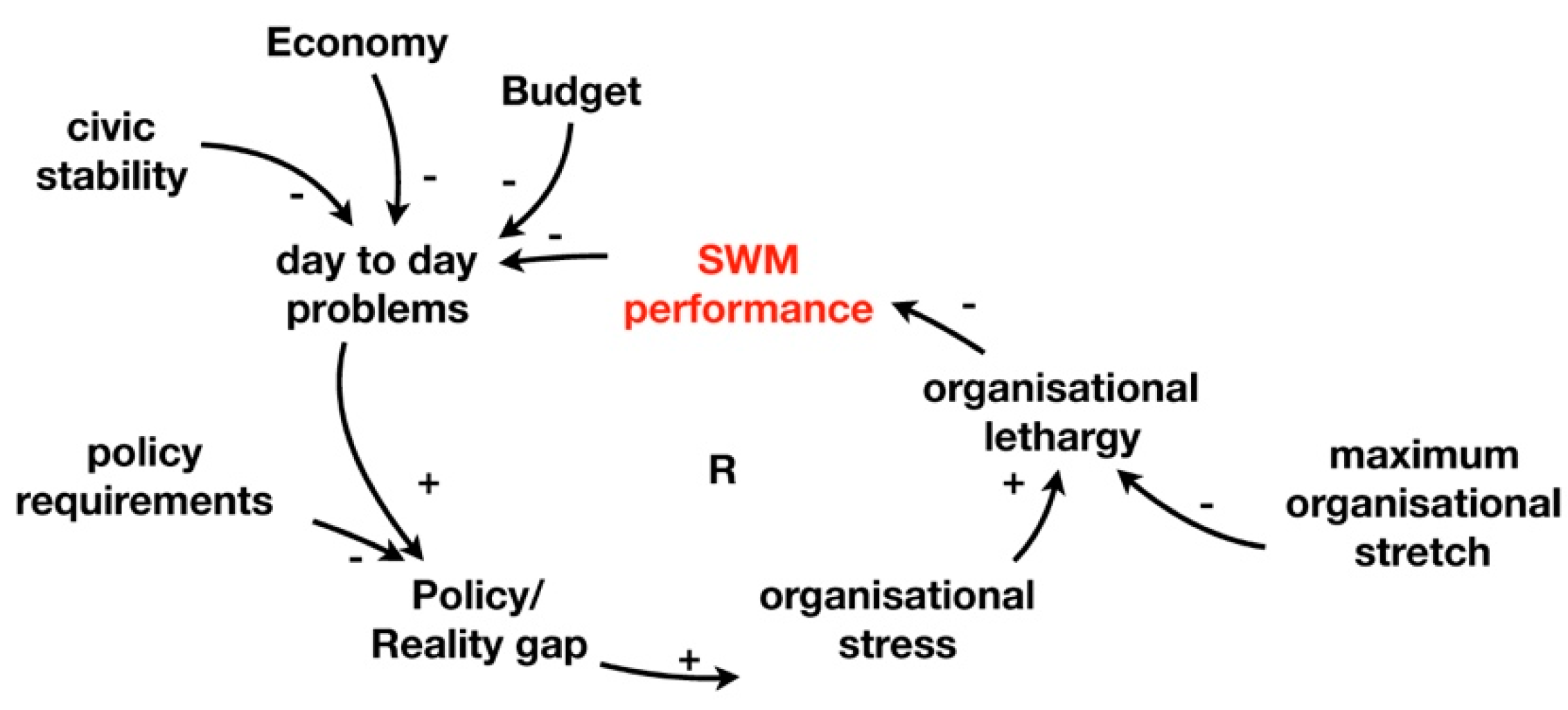Failing Services on Urban Waste Management in Developing Countries: A Review on Symptoms, Diagnoses, and Interventions
Abstract
1. Introduction
- Can we diagnose why many CDCs fail to provide good SWM services and, in doing so, can we address crucial causes and urban processes affecting this failure?
- Based on this, can we design a conceptual model that may serve as a framework to shape future research in this field and as a tool to analyze feasible interventions as a part of urban governance?
2. Method and Analytical Framework
2.1. Literature Review
- Only cities in low-income and middle-income countries (CDCs) are considered.
- Only larger cities (with more than 0.5 million inhabitants) are considered.
- Only MSW is considered. It includes waste from households, urban services (street sweeping, park maintenance, market waste), and small shops, offices, institutions, schools, restaurants etc., with the latter only for as much as it is collected by the municipality. In an urban setting, it is the most important type of waste because it is all around, it has the most detrimental effects and it is the most visible type of waste.
- The review is restricted to the SWM Backbone of services and infrastructure as defined above, including all technical, social, cultural, financial, organizational, legal, psychological, and governance aspects that play a role in managing them. This restriction leaves out aspects such as prevention, recycling, waste-to-energy, and circular economy.
- As for journals, only peer reviewed academic journals are included.
- As for non-journal sources, only publications (reports, books etc.) are included when referred to in multiple articles.
- Only publications from the last 10 years are considered. Earlier articles are not considered, unless they appeared as interesting references in later publications (via backward snowballing).
- Only articles written in English are considered.
2.2. Analytical Framework
- Heifetz et al. for adaptive leadership by using iterations of the observe–interpret–intervene cycle [37].
- John Boyd for military use by analyzing situations and developing strategies through his observe–orient–decide–act (OODA) cycle [38].
- Van de Ven in formulating research problems through a sequence of situating, grounding, diagnosing, and resolving the problem [39].
- Watkins et al. in assessing development needs using the chain identify–analyze–decide [40].
- Symptoms do not explain; they just signal. In the context of this research, they can be all those signs, indications, facts, variables, and ratios that can be observed, measured, calculated, or in any other way be directly or indirectly derived from the current or past performance of a system. Examples for SWM include waste generation, collection coverage, deployed workforce and equipment, efficiency ratios, facilities (number, quality, capacity), waste treatment characteristics, financial data, involvement of third parties, availability of laws and policies, application of permits, and enforcement.
- Diagnosis uses knowledge, tests, or models to search for plausible root causes and establish the most likely ones [41]. In the framework of this review, a root cause is defined as the most original starting point of a sequence of effects. It can be an exogenous cause, coming from outside the urban system, or endogenous cause, inflicted by urban system deficiencies (inability), or deliberate decisions and actions by urban actors (neglect). In general, multiple causes can be expected.
- Interventions follow from diagnosis (except maybe in crisis situations) and should affect the most important causes in order to have a lasting, effective, and efficient impact. Mechanisms that just diminish the effect or initiate unwanted side effects, should be avoided.
- categorizing their arguments as related to “symptoms”, “diagnosis” or “interventions”;
- thereby, evaluating whether symptoms are portrayed as causes;
- and assessing whether claims are shouldered by evidence by referring to literature or the publication’s results.
3. Results
3.1. Overview
3.2. Symptoms
3.3. Diagnosis
3.4. Interventions
3.5. Data/Tools
4. Discussion
- Multiple authors observe that the absence of transfer stations leads to high collection costs [2,25,58]. The exact relation is not revealed but, obviously, when cities are growing in population, density, traffic, and scale, the time a collection vehicle needs to go from its collection-route towards the dumpsite and back increases exponentially. If transfer stations are available, the effect could be that one truck can do 3 or 4 routes per day instead of one, increasing the collection capacity with the same factor.
- Haregu et al. observed that the number of un-serviced households in Nairobi went down from 90% to 20% in the 1970s but, after this good result, it went up again towards 30% in 2010 and 35% in 2016 [44]. This effect may well be described by SDM, for example, by modeling the accelerating rates of urbanization, urban poverty, and economic growth. Their combined effect on waste growth, sprawl, and traffic may have been so strong that it could not be met by politicians, strategies, budgets, management, investments, and the slow processes they are working in. If, in such a case, the experience on, for example, coping strategies for logistical challenges is lacking, deterioration is accelerated.
- Also, the differences in recycling rates between low, middle, and high-income countries, as described by Wilson et al. [1], may be convincingly described by SDM as the result of the dwindling role of the IS when public authorities and private parties step up and the improving economy is drawing away workers from informal occupations.
5. Conclusions
Author Contributions
Funding
Conflicts of Interest
Appendix A
| Ref. | Year | Geography | Symptoms | Diagnosis | Intervention | Data/Tools |
|---|---|---|---|---|---|---|
| [68] | 2007 | Dhaka (Bangladesh) |
|
| ||
| [46] | 2008 | Accra (Ghana) |
|
| ||
| [14] | 2009 | India, 59 cities. |
|
| ||
| [11] | 2010 | Global, 20 developed and developing cities |
|
| ||
| [16] | 2010 | Kathmandu (Nepal) |
| |||
| [17] | 2011 | Global, 20 developed and developing cities. |
|
|
| |
| [26] | 2011 | n.a. |
| |||
| [62] | 2012 | Abuja (Nigeria) |
|
| ||
| [24] | 2012 | Global, 20 developed and developing cities |
|
|
| |
| [70] | 2012 | Gianyar (Indonesia) |
|
|
| |
| [10] | 2012 | Global |
| |||
| [19] | 2013 | Global |
|
|
| |
| [57] | 2013 | 36 cities in developing countries |
|
|
| |
| [21] | 2014 | Global, 5 developed and developing cities |
| |||
| [43] | 2014 | Xiamen Island (China) |
| |||
| [20] | 2014 | Developing countries |
| |||
| [50] | 2014 | Bahir Dar (Ethiopia) |
|
|
| |
| [71] | 2014 | n.a. |
| |||
| [48] | 2015 | Addis Ababa (Ethiopia) |
|
| ||
| [15] | 2015 | 52 cities in India |
| |||
| [56] | 2015 | Kampala (Uganda) |
|
|
| |
| [55] | 2015 | Kampala (Uganda) |
|
| ||
| [51] | 2015 | Makassar (Indonesia) |
|
| ||
| [72] | 2015 | Global |
| |||
| [1] | 2015 | Global |
|
|
| |
| [59] | 2015 | Delhi (India) |
|
|
| |
| [25] | 2015 | Latin-American and Asian countries and Baltic states |
|
| ||
| [18] | 2016 | Global |
|
| ||
| [3] | 2016 | Kinshasa (DR Congo) |
|
|
| |
| [58] | 2016 | Developing countries in Asia |
|
|
|
|
| [69] | 2016 | Bangkok (Thailand) |
|
|
| |
| [53] | 2017 | Amritsar (India) |
|
|
| |
| [44] | 2017 | Nairobi, Mombasa (Kenya) |
|
| ||
| [66] | 2017 | 28 CDCs |
|
|
| |
| [54] | 2017 | Kisumu (Kenya) |
|
| ||
| [64] | 2017 | Indore (India) |
|
| ||
| [61] | 2017 | 20 CDCs |
|
|
| |
| [2] | 2018 | Global |
|
|
| |
| [52] | 2018 | Brazil |
| |||
| [49] | 2018 | Botswana |
| |||
| [47] | 2018 | Kathmandu (Nepal) |
|
| ||
| [63] | 2018 | China |
|
| ||
| [67] | 2018 | Curitiba (Brazil) |
|
| ||
| [45] | 2018 | Dar es Salaam (Tanzania) |
|
|
| |
| [65] | 2018 | India |
| |||
| [60] | 2019 | Gujranwala (Pakistan) |
|
|
| |
| [12] | 2019 | Global |
|
|
References
- Wilson, D.C.; Rodic, L.; Modak, P.; Soos, R.; Rogero, A.; Velis, C.; Lyer, M.; Simonett, O. Global Waste Management Outlook; UNEP: Nairobi, Kenya, 2015; ISBN 9789280734799. [Google Scholar]
- Kaza, S.; Yao, L.; Bhada-Tata, P.; Van Woerden, F. What a Waste 2.0, a Global Snapshot of Solid Waste Management to 2050; World Bank Group: Washington, DC, USA, 2018; ISBN 9781464813290. [Google Scholar]
- Kubanza, N.S. Danny Simatele Urban Environmental Problems: Social and Environmental Injustices in Solid Waste Management in Kinshasa, the Democratic Republic of Congo. Local Environ. 2016, 21, 866–882. [Google Scholar] [CrossRef]
- Cohen, B. Urbanization in developing countries: Current trends, future projections, and key challenges for sustainability. Technol. Soc. 2006, 28, 63–80. [Google Scholar] [CrossRef]
- Zhang, X.Q. The trends, promises and challenges of urbanisation in the world. Habitat Int. 2016, 54, 241–252. [Google Scholar] [CrossRef]
- Cobbinah, P.B.; Erdiaw-Kwasie, M.O.; Amoateng, P. Africa’s urbanisation: Implications for sustainable development. Cities 2015, 47, 62–72. [Google Scholar] [CrossRef]
- Bai, X.; Webb, R.; Elmqvist, T.; Toussaint, J.-P.; Siri, J.G.; Güneralp, B.; Stafford-Smith, M.; Surveyer, A.; Shrivastava, P.; Gatzweiler, F.W.; et al. Defining and advancing a systems approach for sustainable cities. Curr. Opin. Environ. Sustain. 2017, 23, 69–78. [Google Scholar]
- Rodić, L.; Wilson, D.C. Resolving governance issues to achieve priority sustainable development goals related to solid waste management in developing countries. Sustainability 2017, 9, 404. [Google Scholar] [CrossRef]
- Güneralp, B.; Seto, K.C. Environmental impacts of urban growth from an integrated dynamic perspective: A case study of Shenzhen, South China. Glob. Environ. Chang. 2008, 18, 720–735. [Google Scholar] [CrossRef]
- Hoornweg, D.; Bhada-Tata, P. What a Waste. A global Review of Solid Waste Management; World Bank Group: Washington, DC, USA, 2012. [Google Scholar]
- Un-Habitat. Solid Waste Management in the World’s Cities; Scheinberg, A., Ed.; Un-Habitat: Nairobi, Kenya, 2010; ISBN 9781849711692. [Google Scholar]
- Lebreton, L.; Andrady, A. Future scenarios of global plastic waste generation and disposal. Nature 2019, 5, 6. [Google Scholar] [CrossRef]
- Onibokun, A.G. Managing the Monster; International Development Research Center: Ottawa, ON, Canada, 1999; ISBN 0-88936-880-5. [Google Scholar]
- Kumar, S.; Bhattacharyya, J.K.; Vaidya, A.N.; Chakrabarti, T.; Devotta, S.; Akolkar, A.B. Assessment of the status of municipal solid waste management in metro cities, state capitals, class I cities, and class II towns in India: An insight. Waste Manag. 2009, 29, 883–895. [Google Scholar] [CrossRef]
- Gupta, N.; Yadav, K.K.; Kumar, V. A review on current status of municipal solid waste management in India. J. Environ. Sci. (China) 2015, 37, 206–217. [Google Scholar] [CrossRef]
- Urynowicz, M.A.; Reddy, J.M.; Pretz, C.R.; Gerow, K.G.; Dangi, M.B. Municipal solid waste generation in Kathmandu, Nepal. J. Environ. Manag. 2010, 92, 240–249. [Google Scholar]
- Scheinberg, A. Value Added: Modes of Sustainable Recycling in the Modernisation of Waste Management Systems. Ph.D. Thesis, Wageningen University, Wageningen, The Netherlands, 2011. [Google Scholar]
- Ma, J.; Hipel, K.W. Exploring social dimensions of municipal solid waste management around the globe—A systematic literature review. Waste Manag. 2016, 56, 3–12. [Google Scholar] [CrossRef] [PubMed]
- Marshall, R.E.; Farahbakhsh, K. Systems approaches to integrated solid waste management in developing countries. Waste Manag. 2013, 33, 988–1003. [Google Scholar] [CrossRef] [PubMed]
- Zurbrügg, C.; Caniato, M.; Vaccari, M. How assessment methods can support solid waste management in developing countries-a critical review. Sustainability 2014, 6, 545–570. [Google Scholar] [CrossRef]
- Wilson, D.C.; Cowing, M.J.; Oelz, B.; Scheinberg, A.; Stretz, J.; Velis, C.A.; Rodic, L.; Masterson, D.; Vilches, R.; Whiteman, A.D. ‘Wasteaware’ benchmark indicators for integrated sustainable waste management in cities. Waste Manag. 2014, 35, 329–342. [Google Scholar] [CrossRef] [PubMed]
- Löhr, A.; Savelli, H.; Beunen, R.; Kalz, M.; Ragas, A.; Van Belleghem, F. Solutions for global marine litter pollution. Curr. Opin. Environ. Sustain. 2017, 28, 90–99. [Google Scholar] [CrossRef]
- Wilson, D.C.; Velis, C.A.; Rodic, L. Integrated sustainable waste management in developing countries. Waste Resour. Manag. 2013, 166, 52–68. [Google Scholar] [CrossRef]
- Wilson, D.C.; Rodic, L.; Scheinberg, A.; Velis, C.A.; Alabaster, G. Comparative analysis of solid waste management in 20 cities. Waste Manag. Res. 2012, 30, 237–254. [Google Scholar] [CrossRef]
- Leal Filho, W.; Stenmarck, Å.; Kruopienė, J.; Moora, H.; Brandli, L. Benchmarking approaches and methods in the field of urban waste management. J. Clean. Prod. 2015, 112, 4377–4386. [Google Scholar] [CrossRef]
- Chang, N.B.; Pires, A.; Martinho, G. Empowering systems analysis for solid waste management: Challenges, trends, and perspectives. Crit. Rev. Environ. Sci. Technol. 2011, 41, 1449–1530. [Google Scholar] [CrossRef]
- Obeng-Odoom, F. On the origin, meaning, and evaluation of urban governance. Nor. Geogr. Tidsskr. 2012, 66, 204–212. [Google Scholar] [CrossRef]
- Obeng-Odoom, F. Urban Governance in Africa Today: Reframing, Experiences, and Lessons. Growth Chang. 2017, 48, 4–21. [Google Scholar] [CrossRef]
- Harpham, T.; Boateng, K.A. Urban Governance in Relation to the Operation of Urban Services in Developing Countries. Habitat Int. 1997, 21, 65–77. [Google Scholar] [CrossRef]
- Rahmasary, A.N.; Robert, S.; Chang, I.S.; Jing, W.; Park, J.; Bluemling, B.; Koop, S.; van Leeuwen, K. Overcoming the Challenges of Water, Waste and Climate Change in Asian Cities. Environ. Manag. 2019, 63, 520–535. [Google Scholar] [CrossRef] [PubMed]
- Childers, D.L.; Pickett, S.T.A.; Grove, J.M.; Ogden, L.; Whitmer, A. Advancing urban sustainability theory and action: Challenges and opportunities. Landsc. Urban Plan. 2014, 125, 320–328. [Google Scholar] [CrossRef]
- Bai, X.; McPhearson, T.; Cleugh, H.; Nagendra, H.; Tong, X.; Zhu, T.; Zhu, Y.-G. Linking Urbanization and the Environment: Conceptual and Empirical Advances. Annu. Rev. Environ. Resour. 2017, 42, 215–240. [Google Scholar] [CrossRef]
- Mc Phearson, T.; Pickett, S.T.A.; Grimm, N.B.; Niemelä, J.; Alberti, M.; Elmqvist, T.; Weber, C.; Haase, D.; Breuste, J.; Qureshi, S. Advancing Urban Ecology toward a Science of Cities. Bioscience 2016, 66, 198–212. [Google Scholar] [CrossRef]
- Wu, J. Urban ecology and sustainability: The state-of-the-science and future directions. Landsc. Urban Plan. 2014, 125, 209–221. [Google Scholar] [CrossRef]
- Batty, M. The Size, Scale, and Shape of Cities. Science 2008, 319, 769–771. [Google Scholar] [CrossRef]
- Bettencourt, L.M.A. The Origins of Scaling in Cities. Science 2013, 340, 1438–1441. [Google Scholar] [CrossRef]
- Heifetz, R.; Grashow, A.; Linsky, M. The Practice of Adaptive Leadership; Tools and Tactics for Changing Your Organization and the World; Harvard Business Press: Boston, MA, USA, 2009; ISBN 9781422132401. [Google Scholar]
- Osinga, F.P.B. Science, Strategy and War: The Strategic Theory of John Boyd; Routledge: Abingdon, UK, 2007. [Google Scholar]
- Van de Ven, A.H. Engaged Scholarship, A Guide for Organizational and Social Research; Oxford University Press: Oxford, UK, 2007; ISBN 9780199226290. [Google Scholar]
- Watkins, R.; Meiers, M.W.; Visser, Y.L. A Guide to Assessing Needs; The World Bank: Washington, DC, USA, 2012; ISBN 9780821388686. [Google Scholar]
- Rooney, J.J.; Lee, N. Vanden Heuvel Root Cause Analysis for Beginners. Qual. Prog. 2004, 37, 45–53. [Google Scholar]
- Morecroft, J.D.W. Strategic Modelling and Business Dynamics; John Wiley & Sons: Hoboken, NJ, USA, 2015; ISBN 9781118844687. [Google Scholar]
- Xu, Y.; Cui, S.; Lin, T.; Ye, Z.; Xiao, L.; Xu, L. Path analysis of factors influencing household solid waste generation: A case study of Xiamen Island, China. J. Mater. Cycles Waste Manag. 2014, 18, 377–384. [Google Scholar] [CrossRef]
- Haregu, T.N.; Ziraba, A.K.; Aboderin, I.; Amugsi, D.; Muindi, K.; Mberu, B. An assessment of the evolution of Kenya’s solid waste management policies and their implementation in Nairobi and Mombasa: Analysis of policies and practices. Environ. Urban. 2017, 29, 515–532. [Google Scholar] [CrossRef]
- Kazuva, E.; Zhang, J.; Tong, Z.; Si, A.; Na, L. The DPSIR model for environmental risk assessment of municipal solid waste in Dar es Salaam city, Tanzania. Int. J. Environ. Res. Public Health 2018, 15, 1692. [Google Scholar] [CrossRef] [PubMed]
- Fobil, J.N.; Armah, N.A.; Hogarh, J.N.; Carboo, D. The influence of institutions and organizations on urban waste collection systems: An analysis of waste collection system in Accra, Ghana (1985–2000). J. Environ. Manage 2008, 86, 262–271. [Google Scholar] [CrossRef] [PubMed]
- Das, B.; Bhave, P.V.; Sapkota, A.; Byanju, R.M. Estimating emissions from open burning of municipal solid waste in municipalities of Nepal. Waste Manag. 2018, 79, 481–490. [Google Scholar] [CrossRef] [PubMed]
- Bjerkli, C.L. Power in waste: Conflicting agendas in planning for integrated solid waste management in Addis Ababa, Ethiopia. Nor. Geogr. Tidsskr. 2015, 69, 18–27. [Google Scholar] [CrossRef]
- Mmereki, D. Current status of waste management in Botswana: A mini-review. Waste Manag. Res. 2018, 36, 555–576. [Google Scholar] [CrossRef]
- Lohri, C.R.; Camenzind, E.J.; Zurbrügg, C. Financial sustainability in municipal solid waste management—Costs and revenues in Bahir Dar, Ethiopia. Waste Manag. 2014, 34, 542–552. [Google Scholar] [CrossRef]
- Permana, A.S.; Towolioe, S.; Aziz, N.A.; Ho, C.S. Sustainable solid waste management practices and perceived cleanliness in a low income city. Habitat Int. 2015, 49, 197–205. [Google Scholar] [CrossRef]
- Cetrulo, T.B.; Marques, R.C.; Cetrulo, N.M.; Pinto, F.S.; Moreira, R.M.; Mendizábal-Cortés, A.D.; Malheiros, T.F. Effectiveness of solid waste policies in developing countries: A case study in Brazil. J. Clean. Prod. 2018, 205, 179–187. [Google Scholar] [CrossRef]
- Sandhu, K.; Burton, P.; Dedekorkut-Howes, A. Between hype and veracity; privatization of municipal solid waste management and its impacts on the informal waste sector. Waste Manag. 2017, 59, 545–556. [Google Scholar] [CrossRef] [PubMed]
- Sibanda, L.K.; Obange, N.; Awuor, F.O. Challenges of Solid Waste Management in Kisumu, Kenya. In Urban Forum; Springer: Berlin/Heidelberg, Germany, 2017; Volume 28, pp. 387–402. [Google Scholar]
- Kinobe, J.R.; Bosona, T.; Gebresenbet, G.; Niwagaba, C.B.; Vinnerås, B. Optimization of waste collection and disposal in Kampala city. Habitat Int. 2015, 49, 126–137. [Google Scholar] [CrossRef]
- Kinobe, J.R.; Niwagaba, C.B.; Gebresenbet, G.; Komakech, A.J.; Vinnerås, B. Mapping out the solid waste generation and collection models: The case of Kampala City. J. Air Waste Manag. Assoc. 2015, 65, 197–205. [Google Scholar]
- Guerrero, L.A.; Maas, G.; Hogland, W. Solid waste management challenges for cities in developing countries. Waste Manag. 2013, 33, 220–232. [Google Scholar] [CrossRef] [PubMed]
- Aleluia, J.; Ferrão, P. Characterization of urban waste management practices in developing Asian countries: A new analytical framework based on waste characteristics and urban dimension. Waste Manag. 2016, 58, 415–429. [Google Scholar] [CrossRef]
- Kafeel, A. A System Dynamics Modeling of Municipal Solid Waste Management Systems in Delhi. Int. J. Res. Eng. Technol. 2015, 01, 628–641. [Google Scholar]
- Ali, M.; Geng, Y.; Robins, D.; Cooper, D.; Roberts, W.; Vogtländer, J. Improvement of waste management practices in a fast expanding sub-megacity in Pakistan, on the basis of qualitative and quantitative indicators. Waste Manag. 2019, 85, 253–263. [Google Scholar] [CrossRef]
- Aparcana, S. Approaches to formalization of the informal waste sector into municipal solid waste management systems in low- and middle-income countries: Review of barriers and success factors. Waste Manag. 2017, 61, 593–607. [Google Scholar] [CrossRef]
- Ezeah, C.; Roberts, C.L. Analysis of barriers and success factors affecting the adoption of sustainable management of municipal solid waste in Nigeria. J. Environ. Manage 2012, 103, 9–14. [Google Scholar] [CrossRef]
- Yang, Q.; He, L.; Liu, X.; Cheng, M. Bayesian-based conflict conversion path discovery for waste management policy implementation in China. Int. J. Confl. Manag. 2018, 29, 347–375. [Google Scholar] [CrossRef]
- Nidugala, G.K.; Pant, A. Cleanest cities in India 2017: Indore’s meteoric rise to no. 1 spot. J. Public Aff. 2017, 17, e1674. [Google Scholar] [CrossRef]
- Chauhan, A.; Singh, A.; Jharkharia, S. An interpretive structural modeling (ISM) and decision-making trail and evaluation laboratory (DEMATEL) method approach for the analysis of barriers of waste recycling in India. J. Air Waste Manag. Assoc. 2018, 68, 100–110. [Google Scholar] [CrossRef] [PubMed]
- Wilson, D.C.; Kanjogera, J.B.; Soós, R.; Briciu, C.; Smith, S.R.; Whiteman, A.D.; Spies, S.; Oelz, B. Operator models for delivering municipal solid waste management services in developing countries. Part A: The evidence base. Waste Manag. Res. 2017, 35, 820–841. [Google Scholar] [CrossRef] [PubMed]
- Da Silva, C.L. Proposal of a dynamic model to evaluate public policies for the circular economy: Scenarios applied to the municipality of Curitiba. Waste Manag. 2018, 78, 456–466. [Google Scholar] [CrossRef]
- Sufian, M.A.; Bala, B.K. Modeling of urban solid waste management system: The case of Dhaka city. Waste Manag. 2007, 27, 858–868. [Google Scholar] [CrossRef]
- Sukholthaman, P.; Sharp, A. A system dynamics model to evaluate effects of source separation of municipal solid waste management: A case of Bangkok, Thailand. Waste Manag. 2016, 52, 50–61. [Google Scholar] [CrossRef]
- Zurbrügg, C.; Gfrerer, M.; Ashadi, H.; Brenner, W.; Küper, D. Determinants of sustainability in solid waste management-The Gianyar Waste Recovery Project in Indonesia. Waste Manag. 2012, 32, 2126–2133. [Google Scholar] [CrossRef]
- Allesch, A.; Brunner, P.H. Assessment methods for solid waste management: A literature review. Waste Manag. Res. 2014, 32, 461–473. [Google Scholar] [CrossRef]
- Kawai, K.; Tasaki, T. Revisiting estimates of municipal solid waste generation per capita and their reliability. J. Mater. Cycles Waste Manag. 2015, 18, 1–13. [Google Scholar] [CrossRef]










© 2019 by the authors. Licensee MDPI, Basel, Switzerland. This article is an open access article distributed under the terms and conditions of the Creative Commons Attribution (CC BY) license (http://creativecommons.org/licenses/by/4.0/).
Share and Cite
Breukelman, H.; Krikke, H.; Löhr, A. Failing Services on Urban Waste Management in Developing Countries: A Review on Symptoms, Diagnoses, and Interventions. Sustainability 2019, 11, 6977. https://doi.org/10.3390/su11246977
Breukelman H, Krikke H, Löhr A. Failing Services on Urban Waste Management in Developing Countries: A Review on Symptoms, Diagnoses, and Interventions. Sustainability. 2019; 11(24):6977. https://doi.org/10.3390/su11246977
Chicago/Turabian StyleBreukelman, Hans, Harold Krikke, and Ansje Löhr. 2019. "Failing Services on Urban Waste Management in Developing Countries: A Review on Symptoms, Diagnoses, and Interventions" Sustainability 11, no. 24: 6977. https://doi.org/10.3390/su11246977
APA StyleBreukelman, H., Krikke, H., & Löhr, A. (2019). Failing Services on Urban Waste Management in Developing Countries: A Review on Symptoms, Diagnoses, and Interventions. Sustainability, 11(24), 6977. https://doi.org/10.3390/su11246977





